SUPPORT OUR TROOPS
Operation Enduring Freedom
Timeline and Photo stories

1996 - Taleban seize control of Kabul and
introduce hard line version of Islam, banning women from work, and introducing
Islamic punishments, which include stoning to death and amputations.
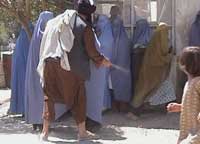 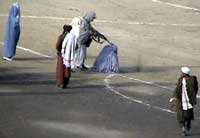
September 9, 2001 - Ahmad Shah Masood,
the Lion of Panjsher", legendary guerrilla and leader of the main opposition to
the Taleban, is killed, apparently by assassins posing as journalists.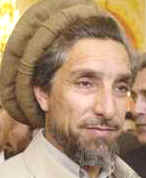
September
11, 2001 - Terrorist attacks kill some 3,000 people in New York,
Pennsylvania, and Washington, D.C.
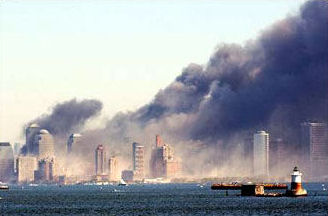
September 12, 2001 - In a
meeting with his National Security teams, President Bush declares the attacks an
act of war against the United States.
Osama bin Laden is named as the enemy mastermind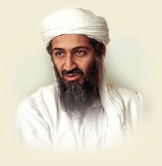 . .
September 14, 2001 - Congress
authorizes the president to "use all necessary and appropriate force against
those nations, organizations, or persons he determines planned, authorized,
committed, or aided the terrorist attacks."
September 20, 2001 - President Bush
addresses both houses of Congress and announces war on terrorism.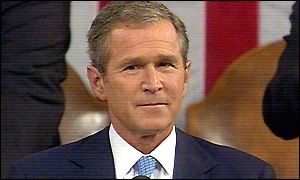

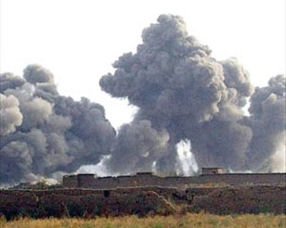
October 7, 2001 - The military phase of
Operation Enduring Freedom has began. US, Britain launch air strikes
against Afghanistan after Taleban refuse to hand over Osama bin Laden, held
responsible for the September 11 attacks on America.
Several weeks of US airstrikes during October and November
allowed opposition forces to sweep through the country and take control of major
cities and provinces.
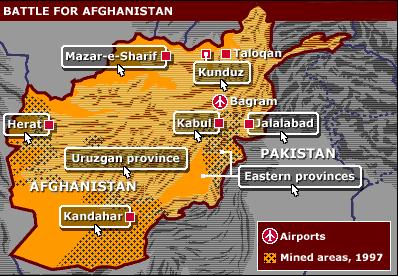
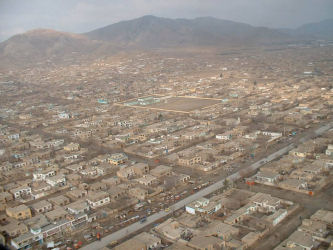
Kabul Kandahar.
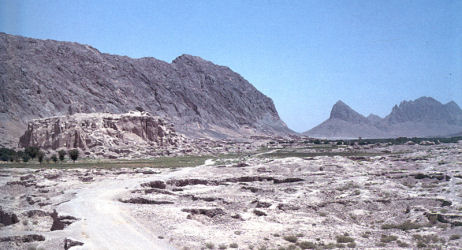
2001 November - Opposition forces seize
Mazar-e Sharif and within days march into Kabul and other key cities.
December 6-7, 2001 - Taleban finally give up
last stronghold of Kandahar. Bin Laden and a thousand followers were believed to
have retreated to the mountains south of Jalalabad on the Pakistan border.
The mountains there contain a cave complex built during the fight against the
Soviets, known as Tora Bora.
December 18, 2001 - Resistance at the caves comes to an end.
American forces commence search and destroy operations. Bin Laden is not
found.
December 22, 2001 - Pashtun royalist Hamid
Karzai is sworn in as head of a 30-member interim power-sharing government.
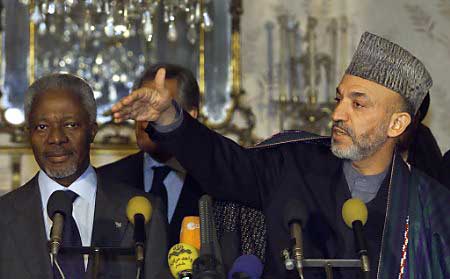
January 2002 - First contingent of foreign
peacekeepers in place.
March 2, 2002 - Two
months after Tora Bora was overrun, Operation Anaconda is launched in the
Shah-i-Kot, near Gardez in eastern Afghanistan. To date, it is the
heaviest ground fighting in Afghanistan. Eight Americans and three Allied
soldiers would be killed in the operation. An estimated 450 enemy were killed as
well.
March 3 -
Resistance is unexpectedly heavy in the Shah-i-Kot.
U.S. aircraft drop 270 bombs on Taliban and al-Qaeda hideouts. Anaconda
now involves more than 1,500 soldiers. In addition to soldiers from the U.S. and
Afghanistan, special forces from Australia, Canada, Germany, Denmark, France and
Norway take part in the push towards the mountains.
March 4 - The allied forces grow to 2,000
as U.S. ground forces take the lead. Seven U.S. soldiers are killed after enemy
rocket-propelled grenade fire downs an MH-47 Chinook helicopter.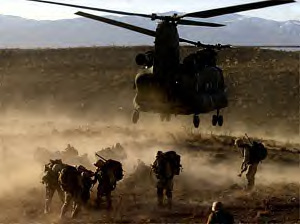
March 6 - Three hundred
additional U.S. troops are called to Shah-i-Kot, making the total U.S. presence
to 1,200. Allied soldiers may have killed as many as 800 al-Qaeda and Taliban
fighters.
March 18 - The U.S. declares Operation Anaconda a success.
However, it is likely that a number of al-Qaeda and Taliban fighters escaped.
May 2002 - UN Security Council extends mandate
of International Security Assistance Force (Isaf) until December 2002.
Allied forces continue their military campaign
to find remnants of al-Qaeda and Taleban forces in the south-east.
June 2002 - Loya Jirga, or grand council, elects
Hamid Karzai as interim head of state. Karzai picks members of his
administration which is to serve until 2004.
July 6, 2002 - Vice-President Haji Abdul Qadir
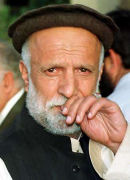 is
assassinated by gunmen in Kabul. is
assassinated by gunmen in Kabul.
August 26 - Operation Mountain Sweep, a weeklong operation in
southeastern Afghanistan, comes to an end.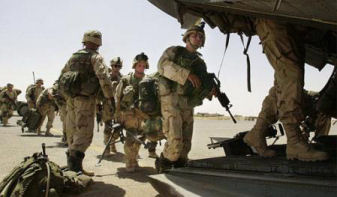 Weapons and Taliban documents have been captured in largest operation since
Anaconda. The operation included five combat air assault missions
and three major convoy road marches. There were more than 2,000 coalition forces
on the ground including seven companies of Airborne and Ranger Infantry, combat
engineers, elements of three aviation battalions and civil affairs officials,
and several coalition Special Operations units with Afghan militia.
Weapons and Taliban documents have been captured in largest operation since
Anaconda. The operation included five combat air assault missions
and three major convoy road marches. There were more than 2,000 coalition forces
on the ground including seven companies of Airborne and Ranger Infantry, combat
engineers, elements of three aviation battalions and civil affairs officials,
and several coalition Special Operations units with Afghan militia.
September 2002 - Karzai narrowly escapes an assassination
attempt in Kandahar, his home town.
August 2003 - Nato takes control of security in Kabul.
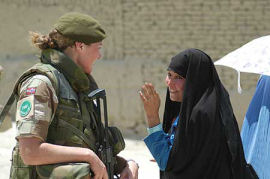 It is
the organization's first operational commitment outside Europe in its history. It is
the organization's first operational commitment outside Europe in its history.
NEW CONSTITUTION
January 2004 - Grand assembly - or Loya Jirga - adopts new
constitution which provides for strong presidency.
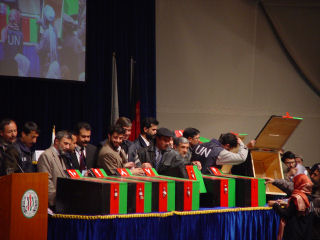

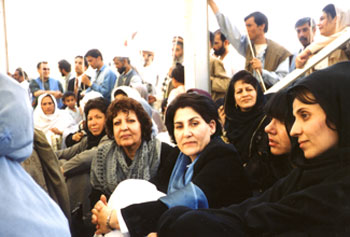
Rona Popal participating at the loya jirga
2004 March - Afghanistan secures $8.2bn (£4.5bn) in aid over three
years.
2004 September - Rocket fired at helicopter carrying President Karzai
misses its target. It is the most serious attempt on his life since
September 2002.

Poster urges
women to vote in presidential poll
Winner Hamid Karzai was challenged by 15 other
candidates....More than 10.5m registered voters.
Feared militant violence did not materialise
2004 October/November - Presidential elections: Hamid Karzai is
declared the winner, with 55% of the vote. He is sworn in, amid tight security,
in December.

Afghans vote in landmark poll
September 18, 2005 - Afghans vote in the first
parliamentary and provincial elections in more than 30 years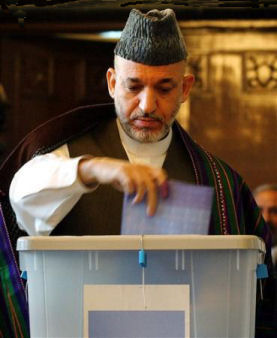
Sunday's landmark election for representatives to the national parliament
and local legislators in 34 provinces came after weeks of violence by militants
trying to derail the vote.
Violence was a continuing threat, but the U.N.-Afghan
election commission said voting had been relatively peaceful, and the government
said the poll was a victory over the insurgents.
"We have not had a single civilian casualty," Interior Ministry spokesman
Lutfullah Mashal said.
"It went very well, beyond our expectations. After all their boasting, it's a
big failure for the Taliban."
Afghan President Hamid Karzai places his ballot for
the Afghan parliamentary election in Kabul, Afghanistan on Sunday, September 18,
2005. The Afghan people braved threats of violence on Sunday to vote in landmark
legislative elections, with some 12.4 million Afghans registered to vote at more
than 6,100 polling stations, which are guarded by some 100,000 Afghan police and
soldiers and 30,000 foreign troops, all supporting this fragile democracy after
decades of war.

FROM JOSHUAPUNDIT
Operation Mountain Thrust, the US-led offensive in southern Afghanistan --
which has led to the killing of 600 to 700 Taliban and other opposition fighters
- is being wound up overnight as control of the region is transferred from the
Americans to NATO.
The US 10th Mountain Division and other forces carried out an effective attack
against the jihadis on their home ground under unbelievable conditions in what
was supposed to be impassable terrain.
This offensive, part of which involved landing fully loaded CH-47 heliocopters
on top of a mountain , in hostile territory and in an area that was 60 miles
away from the nearest ground forces, where no one had been for years was
designed to outflank the mujahadeen and was carried out almost flawlessly.
Absolutely un-freaking-believable, and an amazing feat of arms by some amazing
men.
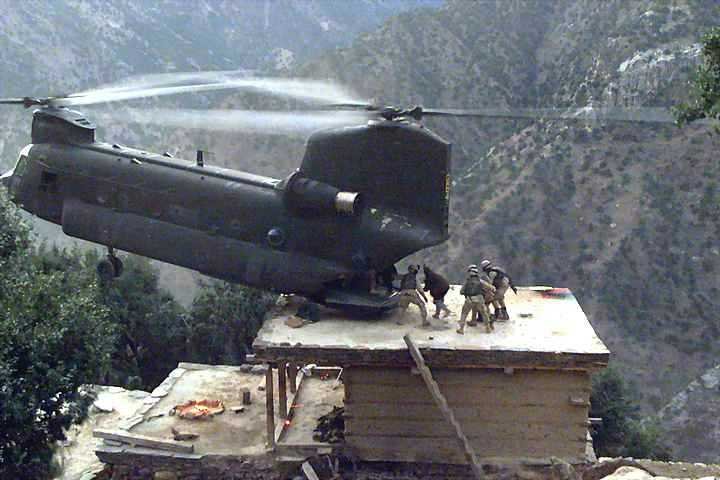
This photo was taken by a soldier in Afghanistan of a helo rescue mission. The
pilot is a PA Guard guy who flies EMS choppers in civilian life. Now how many
people on the planet you reckon could set the rear end of a chopper down on the
roof top of a shack on a steep mountain cliff and hold it there while soldiers
load wounded men in the rear?

The British commander of NATO's International Security Assistance Force,
Lieutenant General David Richards, took over command of southern Afghanistan in
stage three of NATO's expansion in the country, during a ceremony in Kandahar
yesterday.
NATO will take over security in six Afghan provinces in the south of the
country..a Taliban stronghold until the American led forces got through with it.
"NATO is here for the long term, for as long as the Government and people of
Afghanistan require our assistance," Lieutenant General Richards said.
Until yesterday NATO had been in charge of security in the capital Kabul and the
safer north and west of the country.
"Today's transfer of authority demonstrates to the Afghan people that there is a
strong commitment on the part of the international community to further extend
security into the southern region's provinces," said Lieutenant General Karl
Eikenberry, the commander of the coalition forces.
"This is a seamless transfer of responsibility and authority from the US-led
coalition to NATO-ISAF. Having NATO committed to Afghanistan's future is good
for the Afghan people and the entire international community."
Lieutenant General Eikenberry will remain in charge of eastern Afghanistan until
NATO takes over in the east in about a month.

NATO Assumes Command in Southern Afghanistan
Tuesday August 01st 2006 | Filed under: Military, Afghanistan, Politics
There’s not much attention paid to Afghanistan these days but an important
transition just occured:
NATO’s International Security Assistance Force assumed command from coalition
forces in southern Afghanistan today, continuing a process that began with the
establishment of ISAF in Kabul in August 2003.
The NATO-ISAF forces operating in Regional Command South come from Australia,
Britain, Canada, Estonia, Denmark, the Netherlands, Romania and the United
States. NATO-ISAF forces have been flowing into the south for several months,
preparing for the transfer of authority. When fully deployed, the force will
total about 8,000 troops in the area, bringing the total ISAF force level to
about 18,500.
The southern Afghanistan area of operations includes six provinces - Day Kundi,
Helmand, Kandahar, Nimroz, Uruzgan and Zabul.
It’s a dangerous, but necessary, mission:
Three British soldiers have been killed after a vehicle patrol was ambushed by
militants in southern Afghanistan.
A fourth soldier was seriously injured in the incident in the north of Helmand
province, the Ministry of Defence said.
The BBC asked Afghans how they felt about the presence of foreign troops in the
country. My favorite response:
I say that the Americans and all the other foreign troops should leave
Afghanistan now.
But then I also worry that if the international forces pull out of Afghanistan,
the country could go back to the old war days.
September 04, 2006
NATO Presses Advantage Against Taliban
The new offensive against the Taliban remnants in Afghanistan, Operation Medusa,
has dealt a severe blow to the forces of Mullah Omar. Over 200 Taliban fighters
have died in the fighting, while NATO has only suffered four combat deaths:
More than 200 Taliban fighters have been killed in a major Nato offensive in
southern Afghanistan, along with four Canadian troops.
Operation Medusa, launched by alliance and Afghan forces in the Panjwai district
of Kandahar province, involved hundreds of troops, backed by warplanes and
helicopter gunships.
A Nato spokesman said: "Reports indicate that more than 200 Taliban fighters
have been killed since Operation Medusa began early on Saturday morning."
He added that Afghan soldiers had captured more than 80 other Taliban.

America, we must be diligent in preserving our Freedoms here
and abroad - Support the people of Democratic countries and condemn those who
rule by murder, fear and lies. Shine the light of truth on the countries
that support terrorism either by deed, word, money or shelter. It is
our duty, as free people, to speak out against all violations against human
rights. If we don't, who will ?
"A number of years ago a president of this country declared that we have a
rendezvous with destiny. In a world where terrorism spreads and the innocent die
we must fulfill our destiny. If not us who? If not now when?" —Ronald Reagan


Click on scroll bar to return to top or
use button below

Last
Update:
September 04, 2014
|